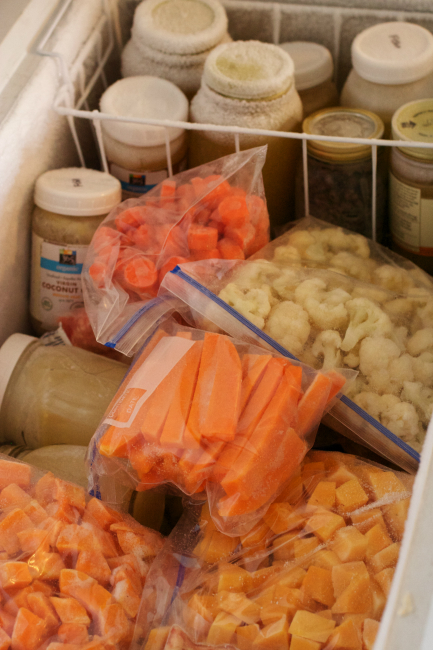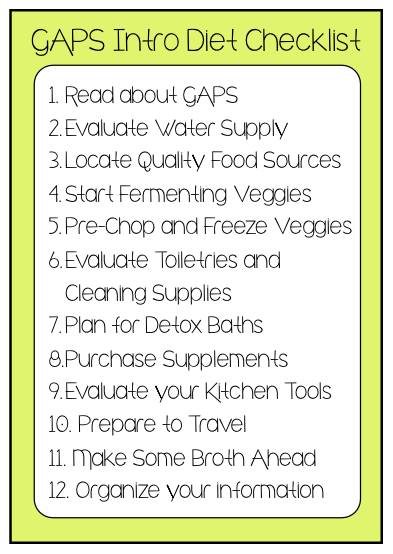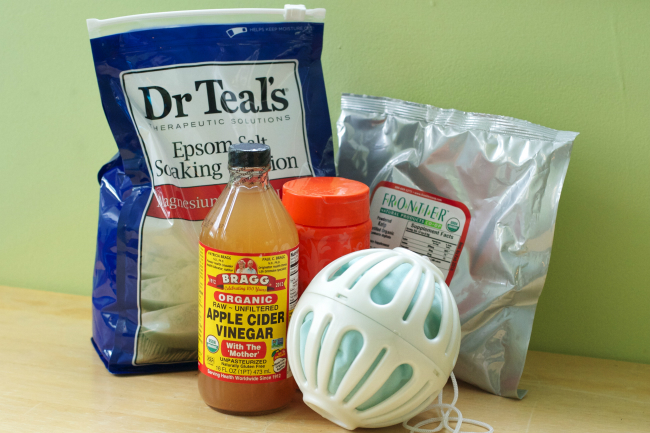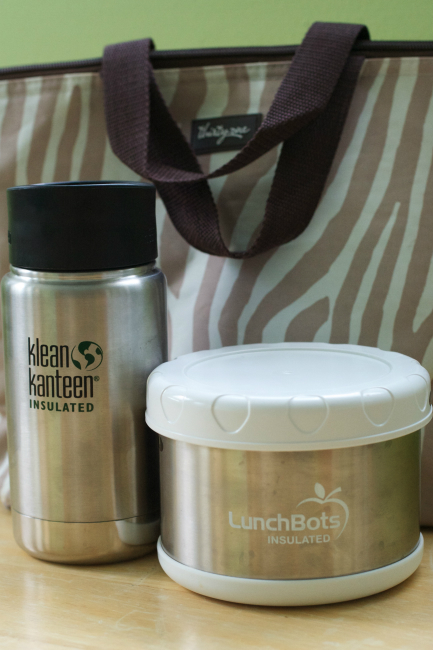Preparing for GAPS Intro: My 12 Step Checklist
I’m gonna be straight with you. Preparing for GAPS Intro has taken a lot of time and brain power for me. If anyone out there is overwhelmed by the idea of starting this diet, you are not alone! I think I finally have a handle on things, but for a while I felt like I was never going to be ready to actually do this diet (as opposed to just thinking about doing it).
I have been preparing for at least a month (maybe two?), and I’ve been reading and thinking about GAPS for even longer. Do not be discouraged if you don’t have everything you need to start right away. Some folks suggest doing the Full GAPS Diet or working backwards into Intro while you prepare (cut gluten, then grains, then sugar, etc. until you’ve removed all the major food groups) so your body isn’t totally shocked by starting Intro.
I am sharing what worked for me in my preparations. Keep in mind that I have not started the diet yet- I will come back and adjust this post if I have any more recommendations along the way. My hope is that this will be helpful for others who are thinking about taking on GAPS Intro. This is what my on-going checklist looked like as I prepared.
1. Read about GAPS.
- The original GAPS book- Gut and Psychology Syndrome by Dr. Natasha Campbell-McBride is a must-read before starting the diet. It is long and scientific at times (not exactly my favorite type of reading) but it’s important to know why and how this healing diet works.
- Read The GAPS Guide if you can get your hands on it. I hear it’s good, but I haven’t been able to find a copy myself.
- Purchase What Can I Eat Now? by Cara from Health, Home and Happiness. This E-Book is a real life-saver. You definitely need this. There is a detailed 30-day meal plan for GAPS Intro in there- go get it now!! I would also recommend subscribing to her helpful emails.
- Know that the Specific Carbohydrate Diet (SCD) is closely related to the GAPS diet, so many of the SCD-legal recipes you find will work for GAPS as well.
- Find GAPS-friendly blogs and websites like Health, Home and Happiness, The GAPS Guide blog, Loving Our Guts, Pecanbread.com (although I think her recipes go by the SCD diet stages), Nourishing Days, Deliciously Organic, Yummy Inspirations, Keeper of the Home, Gutsy, The Liberated Kitchen, Whole Natural Life, The Urban Hearth, Nourished and Nurtured, Butter Believer, Yolks, Kefir and Gristle, and Too Many Jars In My Kitchen.
2. Evaluate Water Supply.
- Filtered water is recommended on GAPS to reduce toxins in your environment. We purchased a Berkey water filter for our drinking water, a filtered showerhead and a dechlorinating filter for our bathtub (for detox baths). I felt these choices were sufficient for our family’s needs. Other options might be installing a whole-house water filter, using a filtered water pitcher or sink attachment (Brita, PUR and Bobble are popular brands) or using a filtered water bottle (I like the look of Bobble bottles, but I’ve never used one).
3. Locate Quality Food Sources.
- This one is a top priority and can take some time. Start stocking up as soon as you decide you want to take on the Intro diet.
- Protein- GAPS Intro allows beef, lamb, chicken, fish, game and eggs. You will want to look for ground meat, steaks and roasts, wholechicken and fish; but also soup bones (for making bone broth), marrow bones, and organ meats (liver is most “popular”). Find grass-fed, pastured animals locally if you can (EatWild is a good resource). If you can’t find anything in your local area, try US Wellness Meats for quality proteins. (And if you’re up for it, keeping backyard chickens makes the egg-finding really simple.)
- Fats- Only animal fats are legal in GAPS Intro, starting with beef or lamb tallow. Beef and lamb fat comes two ways- as suet (which is animal fat that has not been rendered) and tallow, which is rendered fat (similar to lard/duck fat, etc). Be sure to ask how your fat is coming, you may need to render the fat on your own. The Prairie Homestead has a good tutorial on rendering tallow. US Wellness Meats also sells suet and tallow. Ghee (clarified butter) is allowed in Stage 3 of the Intro, so you can also stock up on grass-fed, pastured butter (like Kerrygold) and make ghee ahead of time as well.
- Produce- Stock up on Stage 1/Stage 2 friendly veggies like onions, carrots, squash (all kinds), cauliflower and broccoli. You will add more produce as you go, so be sure to find a local source of organic vegetables. Consult Local Harvest to find farmers’ markets, co-ops and CSAs in your area. Having a small backyard garden can be helpful and rewarding during this time. I especially recommend planting a few fresh herbs- they will be a welcomed addition to the Intro diet.
- Sea Salt- High quality sea salt is a must for adding to your food and ferments. Try Real Salt, Celtic Sea Salt or any other unrefined salts.
- Other- You will eventually add honey and nut flour to the diet. Raw, local honey is best for healing purposes- check out Honey Locator to find some in your area. I buy blanched almond flour in bulk from Honeyville, but it’s also available in stores (Bob’s Red Mill) or at Trader Joe’s. You may also find it helpful to have some grass-fed gelatin on hand (like Great Lakes), as gelatin is known to assist in healing the lining of the gut.
4. Start Fermenting Veggies.
- Fermented foods are huge on GAPS Intro. You’ll want to start about two weeks before you begin the diet so the liquid is ready to use right away. Cara includes simple recipes for sauerkraut and kimchi in her E-Book to get you started.
- Starting to make fermented foods can seem daunting at first. We are all hoping for great results when we take on the GAPS diet, so we want our ferments to be great, too. There’s a great post on Loving Your Guts about anaerobic fermentation and why it might take your healing to the next level. I am still doing my own research on this; I will keep you updated on my findings.
- At the very least, you’ll need vegetables, salt and mason jars to make ferments. You may also want to look into Pickl-It jars and Harsch crocks as well.

5. Pre-Chop and Freeze Veggies.
- This is purely for convenience, since you will be spending a lot of time in the kitchen and eating a lot of veggies in the first stages of the diet. I filled my freezer with butternut squash (some chopped, some sliced like fries), chopped acorn squash, chopped butterCUP squash (looks similar to acorn squash) and cauliflower and broccoli separated into florets. I chose not to freeze onions or carrots, but feel free to freeze those, too.
- The amount of veggies that you freeze is up to you- based on how many people are doing the diet, how much you think you’ll eat and how long you think you’ll be doing the Intro (the ol’ unpredictable GAPS answer, sorry).
- You can freeze grated garlic (for soups) and ginger (for tea) if that would be helpful to you.
6. Evaluate Toiletries and Cleaning Supplies.
- Since reducing your toxins is important during Intro, you’ll want to take a look at your personal items to see if you need to make any changes. Check out your shampoo, conditioner, soap, deodorant, toothpaste, makeup, lip balm, cleanser and moisturizer. You want to keep it as natural as possible. I highly recommend the E-Book The Holistic Mama’s Guide to Homemade Skincare– my cleanser and moisturizer are both recipes from this book.
- Haircare- the no ‘poo’ method with baking soda and apple cider vinegar, castile soap, 8 homemade shampoos (including dry shampoo).
- Hand Soap- castile soap, homemade or natural soap with minimal ingredients.
- Deodorant- homemade or a trusted brand.
- Toothpaste- flouride or not is your choice, but you can make homemade toothpaste or buy a trusted brand.
- Makeup- Make the switch to natural brands or simply minimize your makeup routine. I like the looks of RMS beauty, though I haven’t tried it yet.
- Don’t forget to check out your seasonal items like sunscreen and bug spray.
- There are tons of recipes out there for homemade cleaning supplies. You can find a replacement for just about anything with a quick search on Google or Pinterest. The most common ingredients are already in your arsenal- baking soda, vinegar, lemon juice, etc. If you’d rather buy your cleaning products, check out Honest Company or Branch Basics.
7. Plan For Detox Baths/Showers.
- Detox Baths- These are recommended every day during GAPS Intro. You want to rotate between epsom salts, raw apple cider vinegar, baking soda and seaweed powder. And again, you’ll want to dechlorinate your water for these baths to be most effective (see Water Supply section above).
- Detox Showers- If you are short on time and you have a shower/tub combo (as opposed to a shower that doesn’t hold water), you can take a shower while letting the water collect in the tub, then add your detox item and sit down in the collected water for a few minutes. Even a bit of detox can do you good (and your shower water gets a second life!).
- Visit the GAPS Guide blog’s Detox Bath FAQ to learn more.
8. Purchase Supplements. (GAPS Supplement Guidelines)
- Prescription Strength Probiotic- BioKult is often recommended; I use Prescript Assist (as suggested by my nutritionist).
- Fermented Cod Liver Oil- Green Pasture is the way to go for FCLO. I will introduce the FCLO in Stage 2 when “fermented fish” is allowed. I personally use the blend with High Vitamin Butter Oil in Cinnamon Tingle. If you are clueless about FCLO, check out Green Pasture’s FAQs or Balanced Bites. (You might read this, too- a family who stopped taking FCLO. Interesting thoughts.)
- Digestive Enzymes- these are not essential, but often recommended. See Digestive Enzymes 101.
9. Evaluate Your Kitchen Tools.
- You will be doing things a little differently in the kitchen on GAPS Intro. You may need to put some of your oft-used appliances in storage and make room for other items.
- Things you’ll definitely need- large stock pot, non-toxic pots and pans (no aluminum- try stainless steel, cast iron, enamel, stoneware), slow cooker, immersion blender or stand blender (if you like creamy soups), good quality knives, mason jars of various sizes and some plastic lids, thermoses for soup and bone broth, a juicer (unless you plan to skip out on that part. you can also “juice” with a blender by blending fruit/veg and pressing it through a strainer), strainers, skinny spatulas (for scraping out jars).
- Things you might need- dehydrator (for nuts, you can also do this in an oven), food processor (if you don’t like chopping veggies), garlic press (if you don’t want to chop garlic at every meal), spiral vegetable cutter (if you want to make vegetable ‘noodles’).
10. Prepare to Travel.
- Most of us cannot afford to hibernate in our houses for 4-6 weeks while we work through the Intro diet. You’re going to need to prepare to take your GAPS food out of the house.
- Essentials for GAPS on-the-go include an insulated thermos for broth (I like Kleen Kanteen), an insulated soup container, some dish towels (for inevitable soup spills), an insulated lunch bag (I have a thermal tote from ThirtyOne). For cold or room temperature items, look for glass containers with tight-fitting lids (Pyrex is a readily available brand).
- If you’re heading out for more than a day, you’ll want to make food ahead and be sure to have extra storage containers. Find a hotel with a mini-kitchen if you can or stay in a home so meal prep is easier. Remember to pack your bathtub filter and any detox items, supplements, filtered drinking water, all your food and plenty of broth.
- For more tips on traveling during the GAPS diet, visit Loving Our Guts.
11. Make Some Broth Ahead.
- You’ll be drinking a ton of bone broth on GAPS Intro (and full GAPS), so you want to make a batch or two (or more) ahead of time and freeze them. You can then thaw them in the refrigerator as needed for soups or drinking. You can find my thoughts and tips on bone broth here.
12. Organize Your Information.
- This has been one of the most helpful preparations I’ve made (I have to keep things organized to keep my head above water). I took an old binder and filled it with all of the GAPS Intro information I’ve been compiling. There is a tab for each stage that includes the list of legal foods, the daily menus from What Can I Eat Now?, a place to take notes and document my symptoms and extra recipe ideas.
- I also find it helpful to keep a GAPS board on Pinterest to collect recipes and helpful posts. You can see it here.
If you’ve made it to the end of this post, you must be really interested in starting the GAPS diet- I hope this has been helpful to you! Doing research and getting organized gets you one step closer to healing your body and achieving your goals. You can do it!
*Please feel free to comment with questions or additions to this list.















Hi Natalie!
This is a great list and wonderful resources! We’ve just finished month 1 of the GAPS Diet (still on the intro) and it has most definitely been overwhelming at times and it is a lot of work, but with adequate preparation it can be done. Good job on putting all this together here, I’m sure it can be very handy for people starting!
Cheers (with broth),
Marge
Thanks for the encouragement! I hope GAPS continues to go well with you. 🙂
Hi Natalie!
My husband and I are just now deciding that we want to prepare to do the GAPS diet. I have been cooking from Nourishing Traditions here and there but never full-on. I’ve had a lot of health problems since I’ve had my daughter last summer and have had a couple bouts of mastitis and candida overgrowth, thanks to the antibiotics I’ve taken my whole life. Your blog and this post is very encouraging to me and I praise God for Him helping me find it! I also want to make it available to you and anyone else looking to find a good source for non-toxic beauty and cleaning products. I actually happen to sell some! You can find them at my website http://www.avaandersonnontoxic.com/kirstinkrulikowski
I thank God for you and for your blog! What a blessing!
-Kirstin
You. are. amazing. I need this post in my life. You’ve laid it all out for me! Thank you!
Thanks for all the compiled info. I’m getting ready to start and have been putting this off for WAY to long. i’ve been dairy, gluten free for a long time and refined sugar free off and on….Seeing a holistic dr and trying to heal my long list of health issues, and it’s just time to get this going and work and healing my insides even more thoroughly.